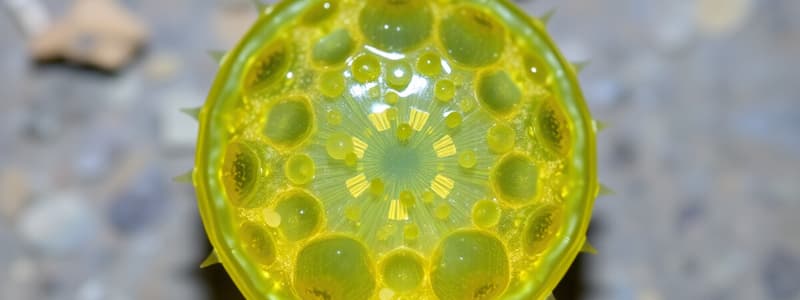Podcast
Questions and Answers
What is a key characteristic of diatom cell walls?
What is a key characteristic of diatom cell walls?
- They are primarily composed of cellulose.
- They form a double-layered structure with silica. (correct)
- They are easily degradable in water.
- They possess a flexible pellicle.
Which of the following statements about dinoflagellates is true?
Which of the following statements about dinoflagellates is true?
- Dinoflagellates lack flagella.
- All dinoflagellates are colorless and non-photosynthetic.
- They can exhibit bioluminescence due to photogenic granules. (correct)
- They exclusively reproduce asexually.
Which of the following modes of nutrition is NOT found in Kingdom Protista?
Which of the following modes of nutrition is NOT found in Kingdom Protista?
- Photosynthetic
- Chemoautotrophic (correct)
- Saprophytic
- Parasitic
What is the primary habitat for members of Kingdom Protista?
What is the primary habitat for members of Kingdom Protista?
Which of the following groups includes organisms known as phytoplankton?
Which of the following groups includes organisms known as phytoplankton?
What type of organisms do euglenoids resemble in terms of pigments?
What type of organisms do euglenoids resemble in terms of pigments?
How do slime moulds behave when conditions are unfavourable?
How do slime moulds behave when conditions are unfavourable?
What characteristics do the spores of slime moulds exhibit?
What characteristics do the spores of slime moulds exhibit?
In which phase do euglenoids behave like heterotrophs?
In which phase do euglenoids behave like heterotrophs?
What is the primary mode of feeding for slime moulds?
What is the primary mode of feeding for slime moulds?
Flashcards are hidden until you start studying
Study Notes
Protista
- A diverse kingdom of single-celled eukaryotes
- Forms a link between plants, animals, and fungi
- Primarily aquatic organisms
- Possesses a well-defined nucleus and membrane-bound organelles
- Some have flagella or cilia
- Reproduce asexually and sexually through cell fusion and zygote formation
- Nutrition varies: parasitic, ingestive, photosynthetic, saprophytic, mixotrophic
- Includes photosynthetic phytoplankton, non-photosynthetic zooplankton, and disease-causing parasites
- Food reserves: starch, glycogen, paramylon, chrysolaminarin, and fat
Chrysophytes
- Includes diatoms and golden algae (desmids)
- Found in freshwater and marine environments
- Microscopic and float passively in water currents (plankton)
- Majority are photosynthetic
- Diatoms are primary producers in oceans
- Diatom cell walls consist of two overlapping shells, fitting like a soap box
- Walls are made of silica, making them indestructible
- Diatom shells accumulate at the bottom of water reservoirs, forming diatomaceous earth
- Diatomaceous earth is used in polishing, filtration of oils and syrups
Dinoflagellates
- Primarily marine and photosynthetic
- Appear yellow, green, brown, blue, or red due to varying pigment proportions
- Cell wall has stiff cellulose plates on the outer surface
- Most have two flagella: one longitudinal and the other transverse
- Red dinoflagellates, like Gonyaulax, multiply rapidly, causing "red tides"
- Toxins released by red tides can kill marine animals, like fish
- Exhibit bioluminescence due to photogenic granules in cytoplasm
- Some species are consumed by mussels
- Also known as "night light"
Euglenoids
- Freshwater organisms found in stagnant water
- Have a protein-rich layer called pellicle instead of a cell wall, allowing flexibility
- Possess two flagella: one short and one long
- Photosynthetic in sunlight
- Behave like heterotrophs in the absence of sunlight, preying on smaller organisms
- Pigments similar to those in higher plants
- Example: Euglena
Slime Moulds
- Saprophytic protists, also called "fungus animals"
- Move along decaying twigs and leaves, engulfing organic matter
- Form an aggregation called plasmodium under suitable conditions
- Plasmodium can grow and spread over large areas
- During unfavorable conditions, the plasmodium differentiates and forms fruiting bodies
- Fruiting bodies bear spores at their tips
- Spores have true walls and are highly resistant, surviving for years
- Spores are dispersed by air currents
- Example: Physarum
Studying That Suits You
Use AI to generate personalized quizzes and flashcards to suit your learning preferences.




